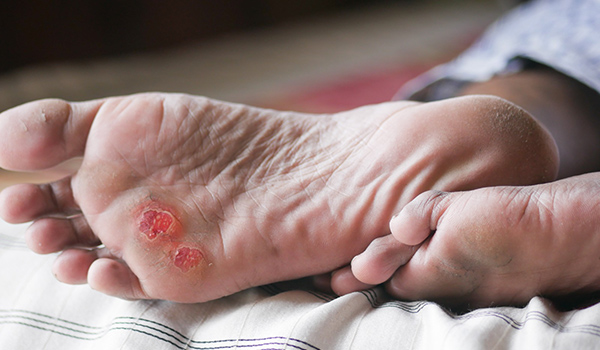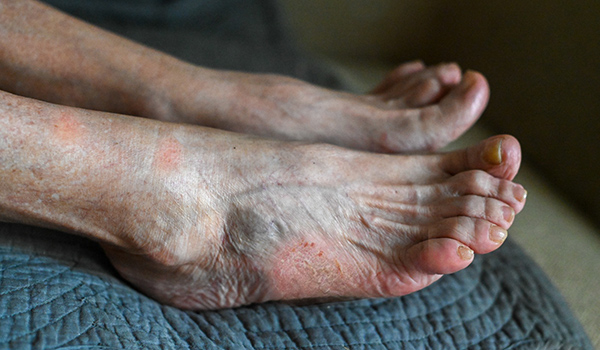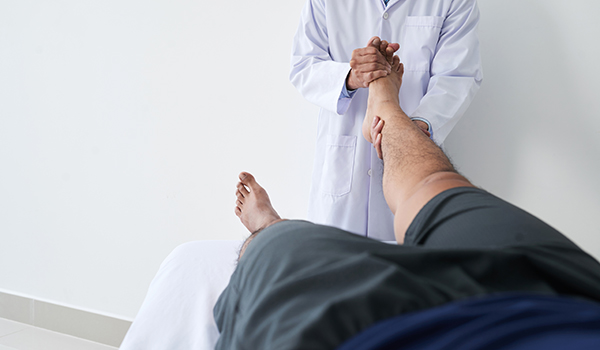Diabetic Foot Ulcers and Wounds
Diabetic foot ulcers describe wounds that do not heal normally and are at high risk of deterioration and infection due to a multitude of interrelated diabetic complications.
UNDERSTANDING DIABETIC FOOT ULCERS AND WOUNDS
Overview
Diabetic foot ulcers and wounds are serious complications that can arise in individuals with diabetes. These conditions result from a combination of factors, including neuropathy (nerve damage), poor circulation, and impaired immune function. Here’s an overview:
It is estimated that 15% of the general population will develop foot ulcers in their lifetime. Among diabetics, this number increases to 25%, and foot ulcers contribute to 84% of all non-traumatic lower leg amputations.
Patients undergoing lower extremity amputation often experience a marked functional decline within five years after the procedure, leading to higher mortality rates.
To combat this, a multidisciplinary approach through preventative measures, regular inspection, and early intervention has been shown to reduce the amputation rate in diabetic patients by up to 50%.
Diabetic foot ulcers can lead to severe complications such as gangrene, tissue death, and, in extreme cases, limb amputation or death from sepsis.


Causes of Diabetic Foot Ulcers
Diabetic foot ulcers typically form due to:
Overloading of a specific foot area
Small abrasions or blisters from unsuitable footwear choices
Ingrown toenails
Risk Factors for Diabetic Foot Ulcers and Wounds
Diabetic foot ulcers typically form due to:
Peripheral neuropathy (nerve damage)
Structural foot deformities (bunions, toe deformities, collapsed foot, Charcot foot)
Peripheral vascular disease (PVD) / peripheral arterial disease (PAD)
Lack of compliance to medical advice
Uncontrolled blood sugar levels
Trauma to the feet and lower limbs
Smoking
Proper patient education regarding foot hygiene, nail care, and footwear choices is crucial to reducing risk factors that can lead to the formation of diabetic ulcers and wounds.

Our podiatrists aim for diabetic patients is to be able to regain a pain-free and active lifestyle with a minimised risk of wounds and infections. Regular foot care and wound management are keys to stabilising the foot condition
Semi-annual diabetic foot examinations should be done to monitor the patient’s foot health and overall risks, so a wound or ulcer can be detected early and prevented from worsening. In cases where a diabetic wound or ulcer has developed, more frequent examinations and interventions become necessary to prevent the escalation to amputation.
How can Diabetic Foot Ulcers and Wounds be managed?
An assessment by a podiatrist will involve a thorough examination and extensive medical history-taking to verify the severity level of your wound. A full diabetic foot examination will be carried out through the use of doppler/ ABPI/ TPBI to check for neuropathy and vascular insufficiency.
How can Diabetic Foot Ulcers and Wounds be managed?
Wound debridement, cleansing, and care using specialised dressings
In-clinic wound management with extracorporeal shockwave therapy (ESWT) to promote healing by boosting circulation and rate of tissue formation
Casting of the lower limb depending as needed (soft, compressive, fixed, removable, fibreglass, plaster of Paris)
Long-term offloading, footwear modifications, and customised orthotics to prevent wound recurrence
Why Are My Diabetic Wounds Not Recovering?
Why Are My Diabetic Wounds Not Recovering?
People with diabetes can experience nerve damage, which can lead to numbness. This can make it difficult to feel pain, resulting in foot injuries such as wounds and fractures going unnoticed. Delayed or improper care due to a state of obliviousness is a likely probability as to why a diabetic wound is not recovering.
Poor blood glucose control
Insulin is the hormone that breaks down glucose to use as energy in the body. Diabetes is the result of the body’s inability to produce consistent insulin, making it difficult to manage blood glucose levels. High blood glucose levels over a prolonged period will cause white blood cells in the body, which are an essential part of the immune system, to be unable to function correctly, fight infection-causing bacteria, and close wounds.
Poor blood circulation
Diabetic individuals have narrowed blood vessels which can slow down blood flow and make it difficult for wounds to receive the required oxygen and nutrients for healing. The effectiveness of white blood cells also decreases, leaving them unable to fight off infections.
Although there is no certain way to cure diabetes, remission is possible with the appropriate management methods. The patient should be responsible for their lifestyle modifications, pharmacotherapy, glycaemic control, and the prevention and management of associated conditions. Furthermore, a reputed medical practitioner with good references to other diabetic specialists should be consulted to drastically increase the chances of success.
How Do I Speed Up The Healing of My Diabetic Wounds?
How Do I Speed Up The Healing of My Diabetic Wounds?
Diet and blood sugar levels are closely linked, and this can have a nonlinear impact on the rate of recovery. People with diabetes should avoid carbohydrates, processed foods, added sugars, and fast food. They should focus on eating foods high in protein, fruit, vegetables, and legumes. A healthy diet can help keep blood sugar levels consistent, improve overall nutrition, and speed up the recovery process. Specialised podiatric methods such as radial shockwave and SIS can also help a patient improve recovery.
Quit smoking
Smoking disrupts the immune system and puts a diabetic individual at a higher risk for many health conditions. This habit also inhibits the ability of red blood cells to bind to and carry oxygen around the body, resulting in impaired healing of injured tissues.
Stay active
Engage in regular exercise to promote good blood flow.
Keep pressure off the affected area
Consistent pressure on a diabetic ulcer can damage the skin further and lead to deeper wounds.
Regular dressing changes
Consistent and meticulous dressing changes are essential for effective wound care. By providing proper attention to wounds and utilising specialised wound care dressings, moisture levels within the wound can be maintained, significantly reducing the risk of infection.
Visit a podiatrist for specialised advice on diabetic wound care. If you have a diabetic ulcer, seek medical care immediately as early intervention can improve chances of healing, avoid the onset of infection and complications, and prevent amputation.
If complications arise, early intervention by specialised healthcare professionals is crucial in preventing the progression of the condition and reducing the risk of amputation.
What are the Common Symptoms?
Foul odour
Swelling
Darkened skin on the affected area
Book your initial podiatry visit
hello@nofrillspodiatry.com
Phone
9007 1085
Open Hours
Mondays - Sundays: 9am-6pm
We're Here Whenever You Need Us
hello@nofrillspodiatry.com
Contact Us
9007 1085
Open Hours
Monday-Sundays: 10am to 7pm
Address
About
About Us
Symptoms We Help With
FAQs
Careers
Contact Us